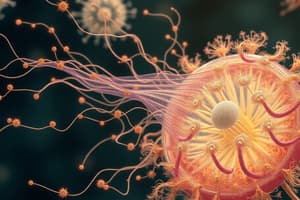Podcast
Questions and Answers
What is the primary method of asexual reproduction in Paramecium and what results from this process?
What is the primary method of asexual reproduction in Paramecium and what results from this process?
Paramecium primarily reproduces asexually through binary fission, resulting in two identical offspring.
Describe the process of sexual reproduction in Paramecium.
Describe the process of sexual reproduction in Paramecium.
Sexual reproduction in Paramecium occurs through conjugation, where two individuals temporarily unite to exchange genetic material.
In what type of environments are Paramecium commonly found, and what conditions do they prefer?
In what type of environments are Paramecium commonly found, and what conditions do they prefer?
Paramecium are commonly found in freshwater environments and prefer warm, neutral waters.
What role do cilia play in the metabolism of Paramecium?
What role do cilia play in the metabolism of Paramecium?
How do contractile vacuoles contribute to the cell structure and function of Paramecium?
How do contractile vacuoles contribute to the cell structure and function of Paramecium?
What are the two types of nuclei found in Paramecium, and what are their functions?
What are the two types of nuclei found in Paramecium, and what are their functions?
What type of feeding process do Paramecium utilize, and how does it occur?
What type of feeding process do Paramecium utilize, and how does it occur?
What are some symbiotic relationships that Paramecium may form, and what benefits do they provide?
What are some symbiotic relationships that Paramecium may form, and what benefits do they provide?
How does the flexible pellicle contribute to the cell structure of Paramecium?
How does the flexible pellicle contribute to the cell structure of Paramecium?
Flashcards are hidden until you start studying
Study Notes
Paramecium
Reproduction
- Asexual reproduction primarily through binary fission.
- Under favorable conditions, a single Paramecium divides into two identical offspring.
- Sexual reproduction occurs through conjugation, where two individuals exchange genetic material.
- Conjugation involves temporary union and formation of a micronucleus.
Habitat
- Commonly found in freshwater environments such as ponds, lakes, and streams.
- Often inhabits decaying organic matter, providing nutrients.
- Can tolerate a range of temperatures and pH levels, but prefers warm, neutral waters.
Metabolism
- Heterotrophic; primarily feeds on bacteria, algae, and small protozoa.
- Utilizes cilia for movement and to create currents that direct food into the oral groove.
- Digestive process occurs in food vacuoles; nutrients are absorbed, and waste is expelled through the anal pore.
Cell Structure
- Size ranges from 50 to 330 micrometers in length.
- Covered by a flexible pellicle that provides shape and protection.
- Contains numerous cilia for locomotion and feeding.
- Features two types of nuclei: macronucleus (controls metabolism) and micronucleus (involved in reproduction).
- Possesses contractile vacuoles for osmoregulation, maintaining water balance.
Symbiotic Relationships
- Can engage in symbiosis with various microorganisms, including bacteria and algae.
- Some species have mutualistic relationships with certain bacteria that assist in digestion.
- May serve as a food source for larger organisms, contributing to the ecosystem balance.
Reproduction
- Asexual reproduction is mainly achieved through binary fission, resulting in two identical offspring.
- Sexual reproduction occurs via conjugation, where genetic material is exchanged between two Paramecia.
- Conjugation involves a temporary union and the formation of a micronucleus to facilitate genetic sharing.
Habitat
- Paramecium thrives in freshwater ecosystems, including ponds, lakes, and streams.
- These organisms often reside in decaying organic matter, which provides essential nutrients for survival.
- They are adaptable to varying temperatures and pH levels but favor warm and neutral water conditions.
Metabolism
- As heterotrophs, Paramecium primarily consume bacteria, algae, and small protozoa for nutrition.
- Movement is facilitated by cilia, which also create currents to guide food into the oral groove for ingestion.
- Digestion occurs within food vacuoles, where nutrients are absorbed; waste is expelled through the anal pore.
Cell Structure
- Paramecium sizes range from 50 to 330 micrometers, displaying significant variability.
- The organism is enveloped by a flexible pellicle, offering both shape and protection from external threats.
- Characterized by numerous cilia that aid in locomotion and feeding activities.
- Contains two nuclei: the macronucleus, responsible for metabolic control, and the micronucleus, which plays a role in reproduction.
- Equipped with contractile vacuoles that help regulate water balance through osmoregulation.
Symbiotic Relationships
- Engages in symbiotic interactions with various microorganisms such as bacteria and algae.
- Certain species form mutualistic partnerships with specific bacteria that facilitate digestion.
- Serves as prey for larger organisms, thereby contributing to the overall balance of the ecosystem.
Studying That Suits You
Use AI to generate personalized quizzes and flashcards to suit your learning preferences.




